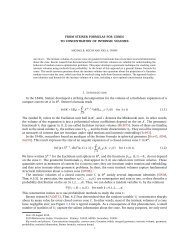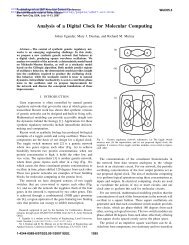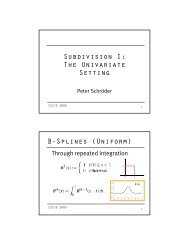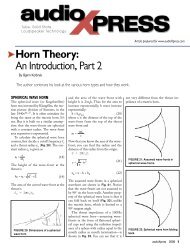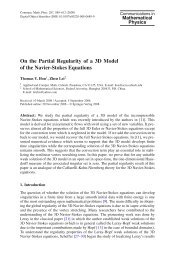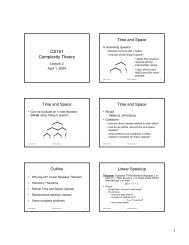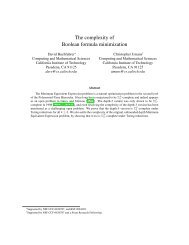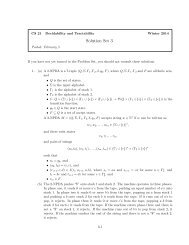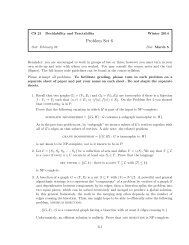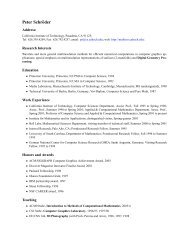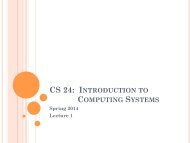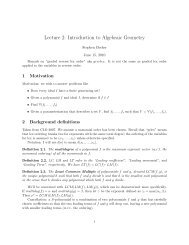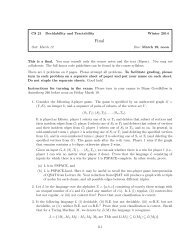FLOWS WITH SURFACE TENSION 333of <strong>the</strong> curve. The spatial resolutions shown are N= 1024<strong>with</strong> At=2.5xlO-4, N=2048 <strong>with</strong> At=1.25xlO-4,N=4096 <strong>with</strong> At=6.25 x 10 -5 , and N=8192 <strong>with</strong> At=3.125 x 10-5. The computations <strong>with</strong> N= 2048 and aboveare computed by restarting Fourier interpolants of lowerresolutions. In particular, <strong>the</strong> N= 2048 computation isrestarted <strong>from</strong> <strong>the</strong> N= 1024 computation at t = 1.25. TheN=4096 and N= 8192 computations are restarted <strong>from</strong>N = 2048 at t = 1.40. These are times at which <strong>the</strong> active spatialspectrum of <strong>the</strong> lower resolution calculations begin toapproach <strong>the</strong> Nyquist frequency. Additional details of <strong>the</strong>secalculations will appear in a separate study [ 28 ].In Fig. 14a, it is seen that <strong>the</strong> time of pinching is adecreasing function of resolution and strongly suggests thatpinching occurs at a finite time. Moreover, <strong>the</strong> width seemsto vanish <strong>with</strong> an infinite slope, implying that <strong>the</strong> pinchingrate intensifies as <strong>the</strong> width narrows. Again, fur<strong>the</strong>r detailswill appear in [ 28 ].This apparent singularity is of a completely different typethan that of <strong>the</strong> S = 0 Kelvin-Helmholtz singularity. Here,<strong>the</strong> singularity is a topological singularity and may signal animminent change in <strong>the</strong> topology of <strong>the</strong> flow. The curvature,vortex sheet strength, and fluid velocity all apparentlydiverge at <strong>the</strong> pinching time [28]. In <strong>the</strong> S = 0 case, it is <strong>the</strong>velocity gradient (strain rate) and <strong>the</strong> curvature thatdiverge, but not 7- More fundamentally, <strong>with</strong> S = 0 <strong>the</strong>singularity occurs through a rapid compression of vorticityalong <strong>the</strong> sheet at a single isolated point [33, 31, 9, 44].Here, <strong>the</strong> divergence occurs through a rapid production ofvorticity that is associated <strong>with</strong> <strong>the</strong> pinching. In a separatestudy, we will show evidence this collapse is a localphenomenon in <strong>the</strong> flow and satisfies a scalingbehavior [28]. We have also derived localized equationsand <strong>the</strong>y are currently under investigation.Error Analysis and <strong>the</strong> Role of Filtering. We now turn toan analysis of <strong>the</strong> errors in our scheme, first by considering<strong>the</strong> energy E(t), which is a conserved quantity not conservedby <strong>the</strong> discrete methods. The energy E is <strong>the</strong> sum of <strong>the</strong> perturbationkinetic and <strong>the</strong> interfacial energies, given bywhereis <strong>the</strong> interfacial energyE( t) = Es( t) + Ek( t), (96)Es(t) = S(L - 1 ) (97)1Ek(t) = ½ fo ~,(o~', t) ~(od, t) d~' (98)is <strong>the</strong> perturbation kinetic energy and ~k is <strong>the</strong> stream function,ff(~, t) = - 2-~ Re {f2 Y(c(, t)× log[sin rc(z(oq t)- z(~', t))] do(}. (99)The formula for ff can be rewritten, by explicitly subtractingoff <strong>the</strong> logarithmic singularity and integrating by parts, toyield an expression that can be computed <strong>with</strong> spectralaccuracy numerically. See Pullin [38] and Baker andNachbin [ 7 ] for details.The lower graph of Fig. 14 shows -lOgl0 [(E(t)-E(O) )/E(O ) I for several spatial resolutions. This is essentiallynumber of accurate digits in <strong>the</strong> energy. The time step isAt= 1.25 x 10 -4 for all <strong>the</strong> resolutions except <strong>the</strong> onemarked 1024ext. This uses At= 3.125 x 10 -5 and uses asinitial data <strong>the</strong> o<strong>the</strong>r N= 1024 computation at t = 0.40.Prior to <strong>the</strong> time t = 0.40, <strong>the</strong>re is essentially no differencebetween <strong>the</strong> different resolutions and <strong>the</strong> errors aredominated by <strong>the</strong> time stepping. Over nine digits ofaccuracy are obtained. Around t = 0.42, <strong>the</strong>re is a suddenoverall decrease in accuracy. This is an effect <strong>from</strong> <strong>the</strong> S = 0Kelvin-Helmholtz singularity. This decrease is primarilydue to time stepping since <strong>the</strong> N= 512, 1024, and 2048 curvesall lie on top of one ano<strong>the</strong>r immediately afterwards.This is reinforced by <strong>the</strong> 1024ext curve which has a fourtimes smaller time step and lies well above <strong>the</strong> o<strong>the</strong>rs. Fromt = 0.43 until nearly <strong>the</strong> end of <strong>the</strong> computation, <strong>the</strong> energychanges only slowly, and <strong>the</strong> N = 1024 and 2048 computationsare slightly more accurate than <strong>the</strong> N= 512. Aroundt = 1.40, when <strong>the</strong> pinching begins to take place, <strong>the</strong>re isano<strong>the</strong>r sudden loss of accuracy and now N = 2048 is moreaccurate than N= 1024 as spatial resolution becomes veryimportant.In view of <strong>the</strong>se results, our code would certainly benefit<strong>from</strong> adaptive time stepping. A small time step is really onlyneeded near <strong>the</strong> Kelvin-Helmholtz singularity time andnear <strong>the</strong> time of pinching. Larger time steps could likely beused safely for <strong>the</strong> remainder of <strong>the</strong> computation. Finally,we remark that <strong>the</strong> energy of <strong>the</strong> N= 8192 computationused to compute <strong>the</strong> pinching distance still has over sixdigits of accuracy at <strong>the</strong> pinching time [ 28 ].Since <strong>the</strong> energy is an integral quantity, using it tomeasure error is smoo<strong>the</strong>r than using a pointwise error. Asin <strong>the</strong> Hele-Shaw case, we also consider <strong>the</strong> pointwise errorin <strong>the</strong> x-component of <strong>the</strong> interface position. In Fig. 15,-lOgl0(e~t)) is plotted (see <strong>the</strong> Hele-Shaw results for adefinition of eN), <strong>with</strong> <strong>the</strong> N = 2048 calculation again usedas an approximation of <strong>the</strong> exact solution. Several resolutionsare graphed and all use <strong>the</strong> time step At = 1.25 x 10-4.This graph is qualitatively similar to that of <strong>the</strong> energy anddemonstrates <strong>the</strong> spatial convergence of our scheme. Thetemporal convergence can be similarly shown, but is notpresented.
334 HOU, LOWENGRUB, AND SHELLEYle',io L,~8• -r64 ,-.',;iI-1024-.-512--256t-J . . . . . . . . . . . . . . . . . . . _.,ItI2 012 0'.4 0'.6 018 ; 1;~ 1.4TFIG. 15. Error in x-coordinate; S=0.005, At= 1.25 x 10 -4, exactsolution approximated by N = 2048.The role of Fourier filtering (H in Eq. (86)) is nowdiscussed. As <strong>the</strong> higher Fourier modes rise above <strong>the</strong>round-off level (due to nonlinear interaction), an aliasinginstability appears. This instability can be controlled byei<strong>the</strong>r increasing <strong>the</strong> resolution or by using some kind offiltering. Both have been tried, and we conclude that it ismore practical to use a high order Fourier filtering thatsmooths <strong>the</strong> highest modes. By this, it is possible to achieve<strong>the</strong> same level of accuracy, at late times, using many fewerpoints than would be required <strong>with</strong>out it. This is seen mostdirectly by comparing <strong>the</strong>ir energies.Figure 16 compares <strong>the</strong> energies of calculations both <strong>with</strong>and <strong>with</strong>out filtering on <strong>the</strong> time interval 0.4 to 0.6. Recall-'xthat <strong>the</strong> filtering combines <strong>the</strong> Fourier and Krasny filters.The effect of Krasny filtering is discussed below. This is avery good test, as <strong>the</strong> spectrum is broadly populated due to<strong>the</strong> effect of <strong>the</strong> S= 0 singularity. The time step is At =1.25 x 10-4 for all <strong>the</strong> calculations. The filtered calculationsshow a generally slower loss of accuracy and are moreaccurate than <strong>the</strong>ir unfiltered counterparts by t = 0.46. Infact, at t = 0.46, <strong>the</strong> N= 256 filtered calculation is moreaccurate than <strong>the</strong> unfiltered N= 1024 computation! Theunfiltered computations both break down before t = 0.6.The aliasing instability can be observed directly in spectralplots of <strong>the</strong> numerical solution. In Figs. 17a, b areshown <strong>the</strong> y-spectra of <strong>the</strong> filtered and unfiltered computations,respectively. In Fig. 17b, <strong>the</strong> aliasing instability isclearly seen through <strong>the</strong> artificial rise in <strong>the</strong> high wavenumberspectrum at t = 0.46. The unfiltered calculation cannotbe continued long after this time, as this rise causes <strong>the</strong> codeto blow up. The filtered computation, on <strong>the</strong> o<strong>the</strong>r hand,does not exhibit such a rise. Moreover, it is really only <strong>the</strong>last few modes that are damped by <strong>the</strong> filtering (modes450-512). Since Krasny filtering is also employed in <strong>the</strong>filtering method, <strong>the</strong> modes at <strong>the</strong> roundoff level 10 -]6 in<strong>the</strong> unsmoo<strong>the</strong>d calculation are set to zero in <strong>the</strong> smoo<strong>the</strong>done. They are seen at <strong>the</strong> 10 -19 level in <strong>the</strong> plot (this kept<strong>the</strong> logarithm function in <strong>the</strong> graphics package <strong>from</strong>diverging). Moreover, it is clear <strong>from</strong> <strong>the</strong> behavior of <strong>the</strong>spectrum of <strong>the</strong> unfiltered computation that roundoff errorsgrow ra<strong>the</strong>r slowly and, <strong>the</strong>refore, <strong>the</strong> main effect of Krasnyfiltering is to keep <strong>the</strong> spectrum clean and is not necessaryfor stability.The spectrum also indicates a very interesting behavior.At <strong>the</strong> early times 0 ~< t ~< 0.46, energy is rapidly moved to<strong>the</strong> high wavenumbers due to <strong>the</strong> near Kelvin-Helrnholtz108:~ 64Number of Aecttrate Digits in Energy, (a)256-- unfiltered20.4 0.42 0,44 0.46 0.48 0.5 0.52T(b)108:g 64"" 10245121024256-- unfiltered- filtered0.54 0.56 0.5820.4 0.42 0.44 0.46 0.48 0.5 0.52 0.54 0.56 0.58TFIG. 16. Accuracy in energy: filtered vs unfiltered, S= 0.005, At =1.25x 10-4: (a) filtered vs unfiltered, N=256, 512, 1024; (b) filtered(N= 512) vs unfiltered (N= 1024).0Filtered C-N, (a)loga01#(k)l- I C 1 ~ - -t=0,42 ~ t=0.46"2G0 100 200 300 400 500 600kUnfiltered C-N, (b)0log10lP(k)l- 1 0 ~ ~---------~ t=0.46 tlogloJ~'(k)l-20 0 100 200 300 400 500 600kFiltered C-N, Later Times, (c)p=1.20 r-20 0 100 200 300 400 500 600kFIG. 17. Log plot of power spectra (log [~(k)l ) at different times,S = 0.005, At = 1.25 x 10 -4, N= 1024: (a) filtered Crank-Nicholson, shorttime; (b) unfiltered C-N, short time; (c) filtered C-N, long time.



